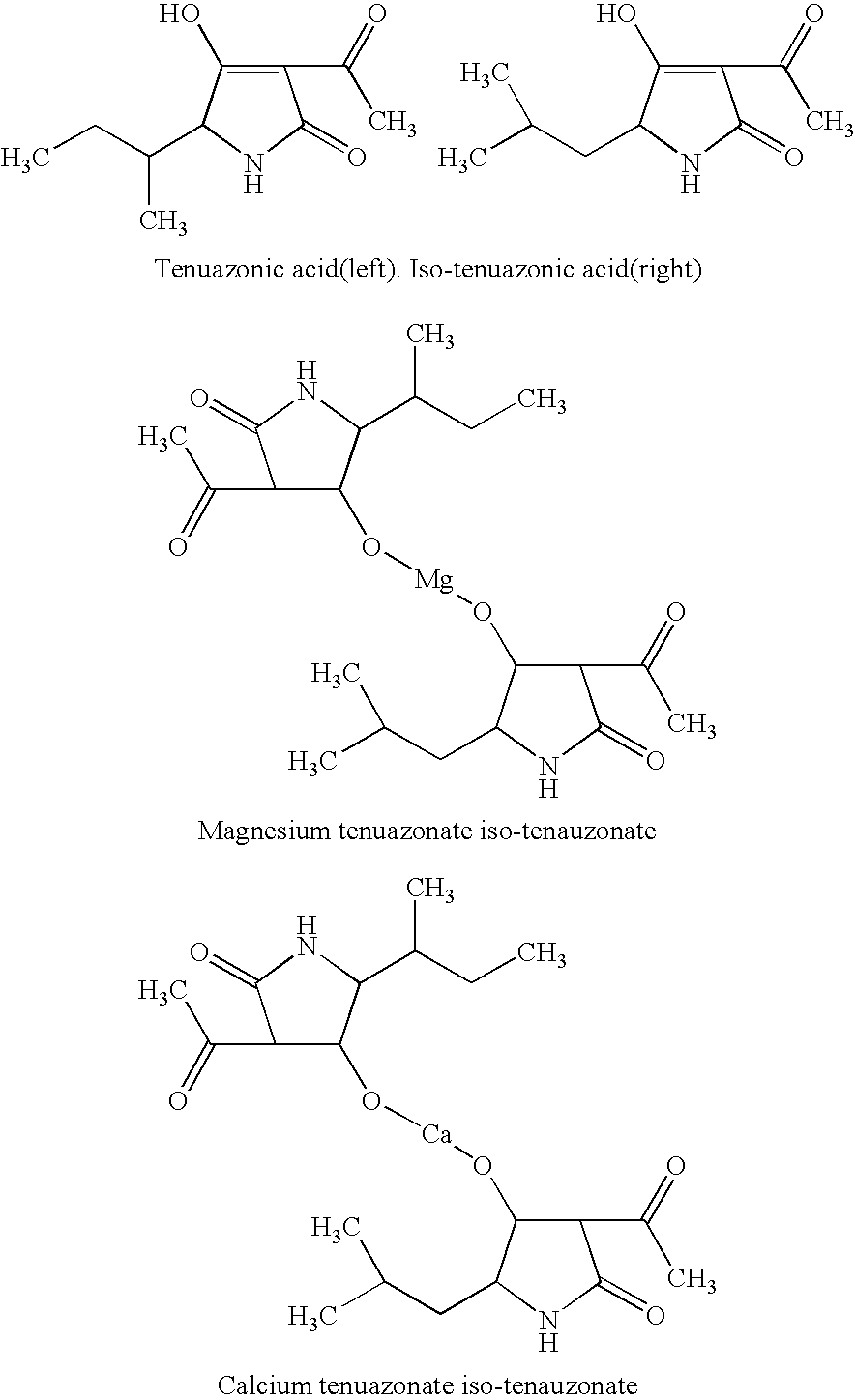Biological Control Of Weeds Using The Metabolites Of Alternaria Alternata
- Summary
- Abstract
- Description
- Claims
- Application Information
AI Technical Summary
Benefits of technology
Problems solved by technology
Method used
Image
Examples
embodiment 1
[0033]21 natural variant strains of Alternaria alternata (Fr.) Keissler, the natural pathogen on Eupatorium adenophorum Spreng., were inoculated on the PDA culture medium, incubated for three days at 25° C. in darkness, and then incubated for seven days at 30 cm under the 15 W ultraviolet lamp, 12 h / 12 h (light / dark), and then spore solution was obtained after washing the cultured medium with sterile water. 105 spores were inoculated on 80 mL PSK substrate, and incubated for six days at 25° C. at the rotate speed of 100 rpm. Culture liquid was filtrated through filter paper, and sterilized for 20 minutes at 121° C., provided for germfree filtrate. The third leaf was first cleared with water, and treated for 35 minutes with 0.1% HgCl2, washed three times. The water on the leaf surface was blot up with sterilized filter paper. Needle puncturing at 1 to 2 cm away from the leaf edge resulted in slight wound, and 20 μL germfree filtrate was imbibed to drop on the needle punctured locati...
embodiment 2
[0035]501 strain was inoculated in SCSC liquid substrate, incubated for 5 to 7 days at 25±1° C. in 12 h light / 12 h dark at the wave speed of 110 rpm. Culture liquid was filtrated with filter paper, filtrate was centrifuged at high speed, supernatant fluid was filtrated with microaperture membrane for germfree filtrate. Gel column chromatogram of 100 to 200 was discontinuously eluted with different solvent systems according to the polarity from low to high.
[0036]The order of elutropic solvent systems added in was petroleum->petroleum:ethyl acetate=5:1->petroleum:ethyl acetate=3:1->petroleum:ethyl acetate=1:1->petroleum:ethyl acetate=1:3->petroleum:ethyl acetate=1:5->ethyl acetate:methanol=5:1->ethyl acetate:methanol=3:1->ethyl acetate:methanol=1:1->ethyl acetate:methanol=1:3->ethyl acetate:methanol=1:5->methanol.
[0037]The method of the second gel column chromatogram was the same as the first. The active part eluted by petroleum:ethyl acetate=5:1 and petroleum:ethyl acetate 3:1 from t...
embodiment 3
[0039]The mixture of tenuazonic acid and iso-tenuazonic acid was dissolved in little methanol, and was respectively confected to 5 μg / g, 10 μg / g, 15 μg / g, 20 μg / g, 25 μg / g, 30 μg / g, 35 μg / g, 40 μg / g solutions with distilled water, at the same time, methanol control and rinsing control of similar concentration were designed, pathogenicity test was conducted with the method of needle puncture on Eupatorium adenophorum sprengel lamina. Every treatment was repeated six times. The spot diameters were measured with vernier caliper after being wetly incubated for 48 hours at 25° C. in natural light.
[0040]The results in Table 2 show that the mixture of tenuazonic acid and iso-tenuazonic acid was high pathogenetic to Eupatorium adenophorum sprengel. The toxicity was already obvious at 5 μg / g, which was close to the toxicity of germfree filtrate, but the difference with control was best apparent (P<0.01).
PUM
 Login to View More
Login to View More Abstract
Description
Claims
Application Information
 Login to View More
Login to View More - R&D
- Intellectual Property
- Life Sciences
- Materials
- Tech Scout
- Unparalleled Data Quality
- Higher Quality Content
- 60% Fewer Hallucinations
Browse by: Latest US Patents, China's latest patents, Technical Efficacy Thesaurus, Application Domain, Technology Topic, Popular Technical Reports.
© 2025 PatSnap. All rights reserved.Legal|Privacy policy|Modern Slavery Act Transparency Statement|Sitemap|About US| Contact US: help@patsnap.com

